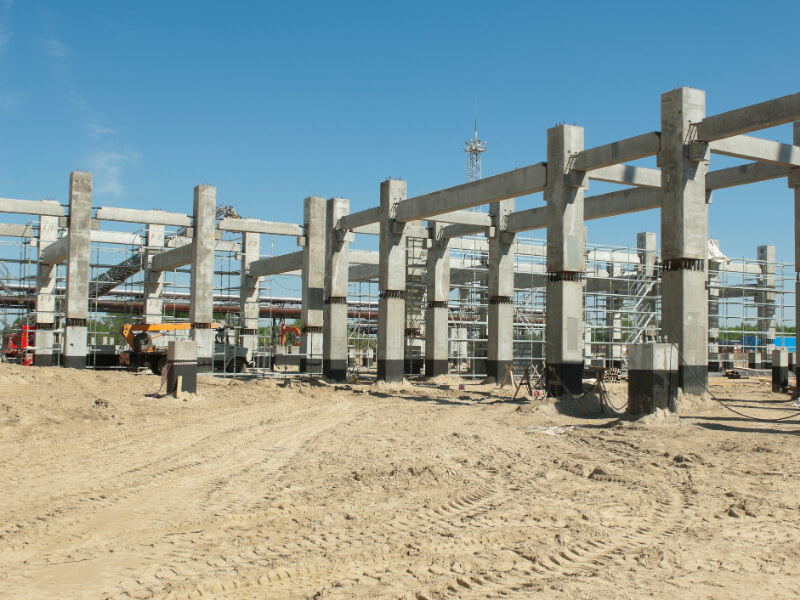
Metals, especially steel, are essential for the construction of large structures. Without them, buildings wouldn't be possible, as concrete alone lacks the necessary qualities. One of the main applications of metal structures in various environments today is as support pillars.
Choosing the right materials is essential to ensure the integrity and safety of any structure, especially large ones. Therefore, you should understand the types of metal pillars used in construction and their main applications.
Follow and understand how these different metal structures influence the quality of your construction.
The primary purpose of pillars is to support the weight of a structure and transfer it to its foundation. When there's a very large suspended area, such as multi-story buildings or warehouses with few walls, it's necessary to add pillars in certain areas to distribute the weight and prevent damage to the structure.
Many materials are used in the construction of pillars, such as wood, stone, or concrete. However, in many cases, they are also metal structures, especially when it comes to large-scale projects.
This happens because the steel in civil construction It offers both strength and flexibility to the pillars. Furthermore, it also creates lighter structures, which contributes to fast and easy-to-maintain construction.
The way steel is applied makes a big difference in its usability. Therefore, there are different types of metal pillars you can use in a project. See the main types and when they're recommended.
Isolated pillars do not use concrete in their composition, that is, only the structural steel It's responsible for all the support. It's not the most common method in complex structures like houses and buildings, but you'll find these pillars mainly in warehouses, where their purpose is to support a series of relatively light roof tiles.
This is also the easiest model to manufacture and build, as there's little to consider other than the metal skeleton. And with a lighter structure, fewer pillars are required, which also increases the available usable space.
Alternatively, composite columns can be used, which utilize both structural steel and concrete. This is the most common type of column in buildings and homes, as it combines the strength of reinforced concrete with the greater flexibility of metal.
However, there are still several ways to create a composite pillar. Learn about the main types.
In this case, the metal column is only partially encased in concrete. The most common approach is to use a steel column with an H-shaped profile, spanning the space between the parallel planes to form a closed square.
This alternative makes good use of available space, while still giving the metal structures much greater strength, which is crucial for larger constructions. Furthermore, the concrete serves as passive protection for the steel, reducing its wear over time.
As the name suggests, these steel pillars are completely covered in concrete, which forms the core of the structure. One of the main advantages of this alternative is that, during construction, it can significantly speed up the assembly process.
It works like this: the metal structure is assembled first, providing enough support for the work on the upper floors. At the same time, reinforced concrete is poured into the pillars on the lower floors. In other words, it's necessary to wait for the material to cure before continuing the work.
Another common type of column with great potential is the composite filled type, where concrete is inserted into a hollow metal column, which can be square, circular, or rectangular. In this case, the steel forms a reinforcement around the concrete column.
Its application is even more practical than other types, as the steel serves as a frame for the entire material. Once reinforced, simply pour the concrete and wait. On the other hand, it's necessary to include another form of passive protection for the metal.
During the planning When designing your project, it's important to consider both the number and types of pillars to be used in the construction of the metal structure. Here are the main points to consider.
Steel columns come in different profiles. Each of these shapes results in a different weight distribution, which influences how they are used in construction. It's important to compare these options before choosing which ones to use.
With the advances of technology in civil construction, it's possible to build more durable and lightweight metal structures at the same time. However, they still exert significant pressure on the pillars. Therefore, it's necessary to calculate their total weight and the number of pillars needed to support them.
In addition to weight, it's important to consider available space, as this affects the spacing between pillars. In large areas, such as warehouses, it's best to concentrate more weight on fewer support points to maximize usable area.
The use of metals in civil construction It influences both functionality and aesthetics. Modern buildings tend to be slimmer because they don't require such a wide base. Therefore, the choice of metals and the ideal pillar structure must also be considered from a visual perspective.
As we've seen throughout this content, there are several types of pillars most commonly used in metal structures. We've learned about the main functions of each, which is crucial for decision-making when planning buildings of all sizes.
Now that you better understand the types of pillars and metal structures used in construction, you can decide which is best suited for your project. The most important thing is always to find a good one. supplier for his work.
Read other blog content and learn more about Ceará Steel Group on our website!